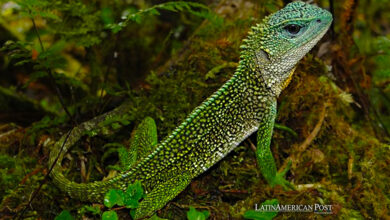What’s Been Doing for Jaguar Preservation in Latin America?
The largest cat in America is classified as "near threatened" according to the Red List of Threatened Species of the International Union for Conservation of Nature (IUCN). We tell you about the efforts in the preservation of the jaguar.

Photo: Pixabay
LatinAmerican Post | Daniel Vergara García
Listen to this article
Leer en español: ¿Qué se está haciendo por la conservación del jaguar en Latinoamérica?
The jaguar is not only threatened by hunting, trafficking, but also by factors such as deforestation, loss of diversity, and the current climate crisis. The Jaguar belongs to the Panterinos subfamily and to the Panthera genus. The Panthera Onca is the only one of the 4 species of this feline found in America. A study published in 2017 by the Oryx magazine (England) states that currently this feline only occupies 51% of the territory it has inhabited for hundreds of years. Its presence in the American continent suffered a great reduction, gradually it went from inhabiting about 19 million square kilometers to only 9,000 square kilometers. It is a territory that stretched from the southwestern United States to Argentina. This poses a serious problem for the nearly 18 Latin American countries where the jaguar is found.
One of the biggest threats to the feline is the loss of its natural habitat. Although the Jaguar has the ability to adapt to diverse ecosystems, the majority of its population is found in subtropical forests and low tropical forests located less than a thousand meters above sea level. With the increasing deforestation in forests and jungles, they have had to migrate to other habitats whose conditions are not optimal for their subsistence. This phenomenon of felling trees is related in several Latin American countries due to the presence of extensive livestock.
Poaching is one of the most complicated problems, it is mainly done to trade un with its skin and tusks. With the ban on the jaguar trade in 1975, the value of this cat on black markets increased. According to a Mongabay investigation, the value of a tusk is around 250 dollars and it is estimated that when it reaches the illegal markets in Asia, its value can double or triple.
In Uruguay and Paraguay the Panthera Onca is Considered Almost Extinct
Regarding the climate crisis, the loss of diversity poses a new challenge for the survival of the jaguar in America. According to the World Wide Fund for Nature (WWF), more than 22 species of mammals (70% of its diet), birds, reptiles and fish have been identified in the diet of this feline. When some species disappear, the possibilities to acquire food are reduced. The increasing disappearance of the Panthera Onca poses a problem for the ecosystems in which it is present, WWF affirms that in this case the jaguar it is a species that helps to maintain a healthy ecosystem. When it disappears from the jungles and forests, its prey, which are usually large herbivores, remain masters of the landscape and consume plant species without control. This disrupt the composition and structure of the forests, of the soils, affecting the riverbeds and, therefore, has a chain effect on other living beings.
You can also read: Gallery: Colombia, the most diverse country in butterflies
What has Being done for their Protection?
Multiple projects are being managed at an inter-institutional level to prevent the problem from increasing. One of the great efforts that Latin America is making as a region was the adoption of the Jaguar 2030 Plan, proposed at COP 14. Panthera's Executive Director of Conservation Sciences, Dr. Howard Quigley, told WWF: "The Plan Jaguar 2030 breathes new life into the world of jaguar conservation, bringing true vision and real solutions for the world to protect this iconic and ecologically essential species, while creating tremendous economic opportunities and a sustainable future for all".
Likewise, WWF works together with 14 Latin American countries to mitigate the conflict between humans and jaguars that occur due to the expansion of crops, expansion of land for livestock through deforestation and hunting. In the same way, some initiatives are carried out from the scientific community for the monitoring of species in the different countries, the collection of information on jaguar trafficking and the protection of their ecosystems.
In Mexico, the veterinarian and regional coordinator of Primero Conservation for Mexico, Ivonne Cassaigne, is carrying out a project to improve the relationship between ranchers and jaguars. The cats were attacking calves to find food and this led the owners to hunt them down. According to an article in Mongabay, after an investigation by Cassaigne, it was possible to infer that the felling of trees was correlated with the attack of cats on livestock. After months of observation, it was possible to deduce that the jaguars preferred other types of animals such as deer instead of cattle, but with the increasing expansion of the territory for livestock, these animals were disappearing and the jaguar resorted to diversifying its possibilities for feeding. Currently, awareness projects are being carried out for farmers to prevent the hunting of these animals and promote a harmonious life.
The same Mongabay article explains that in Colombia there's similar problem but with extensive crops for agricultural use, especially cocoa and coffee. To combat the consequences, a program has been promoted that grants labels called "Jaguar Friendly" to products that are complying with certain requirements for the protection of the feline. José Fernando González, Director of the Water and Land Conservation project, explained to that organization that: “The program consists of giving a Jaguar Friendly certification to coffee grown on farms that meet certain criteria to protect this species. Producing coffee under the shade, avoiding hunting and keeping forests intact in view of the advance of land use change for livestock are some of the guidelines for a jaguar-friendly coffee”.





